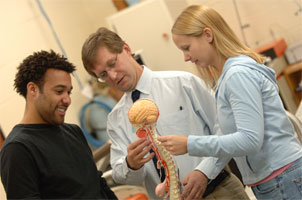Remember the 60-year-old Swede?
In the early 1970s, the image of a 60-year-old Swede jogging effortlessly beside a puffing 30-year-old Canadian was enough to guilt Canadians off the chesterfield and into the gym.
|
It was in this climate that the School of Physical Education ‚ÄĒ later the School of Recreation, Physical and Health Education and now the School of Health and Human Performance ‚ÄĒ was founded 40 years ago. Several years earlier, the federal government had passed its fitness and amateur sport act intended to get Canadians competitive in international sport. It was also fighting the decaying fitness level of the Canadian population by funding research and promoting recreational opportunities.
Dal’s School of Physical Education was created in 1966 as a direct response to the need for trained physical education teachers. While its main focus was teacher preparation, it also offered a second academic stream in human movement studies. The science-oriented degree program later became known as kinesiology.
 |
| The School of Health and Human Performance is teaching and research focused. (Danny Abriel photo) |
‚ÄúThere is a much greater awareness today for the need for healthy practices, but 40 years ago, we had major problems stemming from inactivity and poor nutrition in the general population,‚ÄĚ writes Allan Coles, the school‚Äôs first director in an email from Australia. He left AVĺ„ņ÷≤Ņ to accept a similar challenge in establishing the Department of Human Movement Studies at the University of Queensland. ‚ÄúForty years ago, you would see very few people walking or running on the street or using parks. There were very few health and fitness clubs‚Ķ there was a mindset that needed a fundamental change.‚ÄĚ
As awareness of the need for illness prevention and health promotion increased, the school continued to adapt and change: creating a Bachelor of Science (Health Education) in 1975, a Bachelor of Recreation program in 1977 and a combined five-year Bachelor of Physical Education/Bachelor of Education program in 1984.
|
‚ÄúIt wasn‚Äôt rational in any sense. It was political,‚ÄĚ says associate vice-president academic Larry Maloney, who served as director of the school from 1978 to 1989 and again from 1995 to 2000. ‚ÄúTo see a program, and such a good one, so cavalierly stricken from the books was a blow.‚ÄĚ
The move necessitated significant curricular changes, a new mission for the school and a new name. The School of Health and Human Performance debuted with the mission of enhancing the health and well-being of members of society. A new stream of study in ergonomics was added to the kinesiology program and the therapeutic recreation program was strengthened. As well, a five-year Bachelor Science (Recreation)/ Bachelor of Management program was launched in cooperation with the Faculty of Management.
With the academic programs set, a new director arrived, bringing a focus to the school‚Äôs research side. With a background in rehabilitation medical science, Lori Livingston immediately rolled up her sleeves, recruiting and retaining top-notch faculty with research specialties including biomechanics, childhood obesity, aboriginal health, access to health-care for marginalized populations, and the prevention of HIV/AIDS. The research dollars followed ‚ÄĒ the school now attracts more than $1.5 million in research funding from outside sources, a seven-fold increase since 1999-2000.
‚ÄúIt‚Äôs a matter of prioritizing and putting the appropriate supports in place for those who are research active,‚ÄĚ she explains.
Dr. Livingston‚Äôs other priority has been to prepare the undergraduate kinesiology program for accreditation. The school‚Äôs program has to meet the kinesiology accreditation standards as outlined by the Canadian Council of University Physical Education and Kinesiology Administrators. Reviewers are expected to arrive at AVĺ„ņ÷≤Ņ next month.
Today, when that 60-year-old Swede just might give a 13-year-old, video-playing, chip-munching Canadian kid a run for the finish line, the school is more relevant than ever. The school is bound by its mission to develop professionals and scholars who can generate, disseminate and apply knowledge to advance health and human performance.
‚ÄúAll of our programs focus on enhancing health,‚ÄĚ says Dr. Maloney. ‚ÄúThere‚Äôs a real need out there for this school, for health promotion, recreation and injury prevention. It‚Äôs what our society needs right now.‚ÄĚ
For more information, please visit the . For a full list of events, see the  (PDF).  

